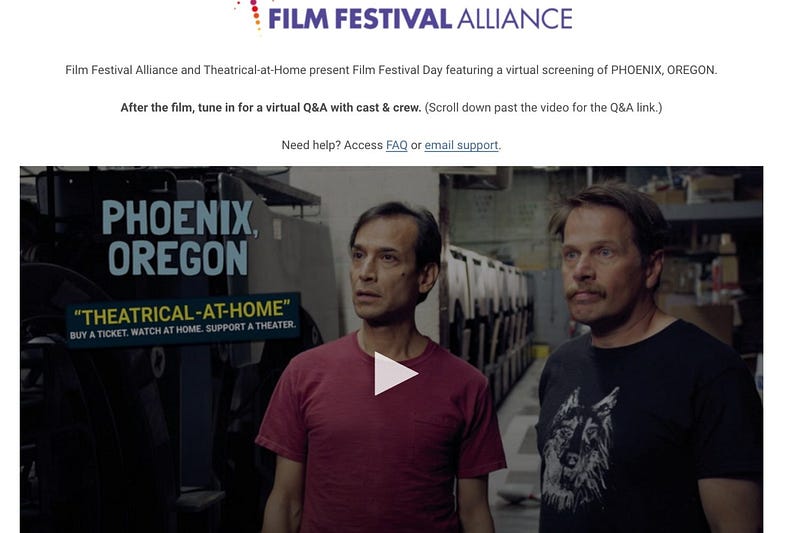
Today’s Film Festival Day with a virtual screening of Phoenix, Oregon and cast & crew Q&A was a huge success. We are very thankful to Film Festival Alliance and the 32 film festivals from around the country for facilitating this event.
We had over a thousand participants and 250 attendees on the live Q&A.
It was fun to see James, Jesse, Diedrich and Gary back together — all on one screen.
The Zoom Webinar worked well, although with it being our first time, we made a few mistakes — mostly funny and not too disruptive.
Learnings from our first webinar:
- Unless you create a waiting room, everyone can hear you getting ready! (Oops)
- Attendees can name themselves “Phoenix, Oregon” and get made the co-host. That was the funniest part of the Q&A. I was trying to figure out who was our “extra” panelist. I turned on her video, and all we could see was the top of a guests head.
- Only the host can add or delete co-hosts.
- Zoom Meeting is not the same as Zoom Webinar and if you change, you need to send out a new link. Thankfully we figured that out in time to update the link for customers.
- Do not put the Zoom link anywhere near the movie link on the website. A handful of poor viewers were waiting for the movie to start in the Zoom room! Once I realized this, I moved the Zoom link to another location on the web page.
- In Zoom Webinar, you can hide any panelists not sharing video. This made it easy to host the meeting behind-the-scenes and only show our cast & crew.
- When we added panelists, we had to scroll through the list of attendees to find the panelist name and then click “Add Panelist”. There is probably a better way to do this. Otherwise, I imagine it would be hard with thousands of participants.
- The Q&A questions are added faster than can be handled, so it’s key to have a method to filter them for the panelists. We had one person monitoring the questions and feeding them to the moderator through a separate chat.
Our Theatrical-At-Home streaming platform worked great as long as folks had the right TV/Device configuration and could easily find their screening link. I fielded about 50 support requests out of 1,000 customers. That’s not too bad, but it’s still too many. It was ok for today, but it’s too many if we scale.
The majority of support requests were from three reasons:
- Did not receive the confirmation link. Some of the order confirmation emails from our payment processor get caught in spam blockers. Until last night, that is the only way we delivered the screening link, so it created at least a few support requests each day. Yesterday, I spent a couple hours on the phone with our email host and payment processor working on email settings with little progress, but there are still a few optimizations I can make. Thankfully I was able to insert script into the online payment confirmation page to provide an immediate link upon purchase.
- How do I watch on my TV? The great majority of people are able to easily screencast from their computer or phone. But some customers have never done this so needed guidance. And for a handful of customers it’s not possible to mirror the JW Player to the TV with an HDMI cable — specifically for Roku and a couple newer models of Samsung TV which is strange. I never imagined I might learn so much about Television configurations, PCs, and web browsers.
- My internet is slow. The video host and player seems to be working well and delivers content at high speed, but the movie still lags for some customers if their internet is slow or if they are watching at a busy time of day when the rest of the world is also watching.
The first issue is mostly solved. The second two, I am not sure. I don’t know enough about streaming technology to understand how the player compares to other options, although I do know that our player was used to live-steam the Super Bowl on Fox.
The verdict is still out on scalability since tech support is provided by a very small team (me mostly). I am a bit surprised that it doesn’t work more seamlessly, but since we have similar issues when trying new technology at our house, maybe it is not so rare. There are very limited options for delivering through a native TV app without licensing the film to all of the major platforms. The technology for that is expensive to create. Some of the on-demand streaming services for filmmakers are better suited to technically support customers, but they are not without issues, and still do not work for every system. They also do not provide the flexibility for partnerships, affiliates, managed payment systems and new feature integration. For what we are doing, we have a workable, flexible platform, but I am unclear of the future use.
We are currently developing events with new partners, and we’ll be considering all of the above in the next few weeks.
~•~
All in all, it was an incredibly successful week where we have almost quadrupled sales from the previous period.
The feedback from the festivals and their patrons was heart-warming and joyful. Everyone seemed so grateful for the opportunity to connect online and talk about art and story-telling.
I’m also feeling very thankful tonight for all of the fans who have been so kind and gracious to me and our team. I’m also thankful for all of my new growth and learnings about user-interface design and content delivery systems.
Certainly it is valuable knowledge for a boot-strapped indie filmmaker.
♡ Annie
